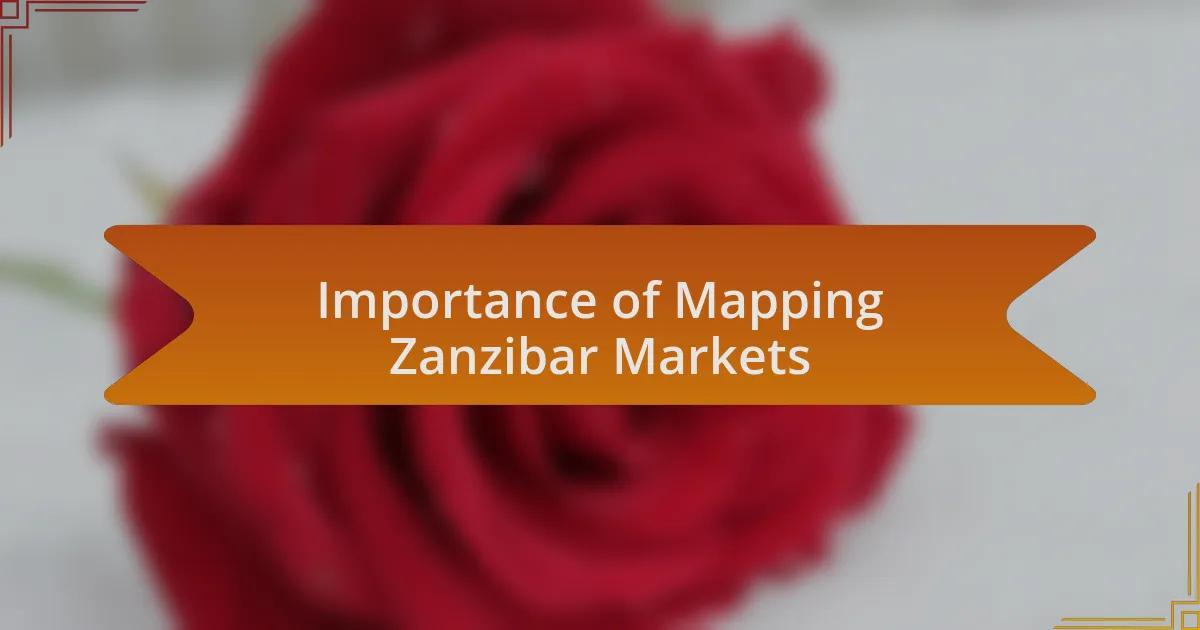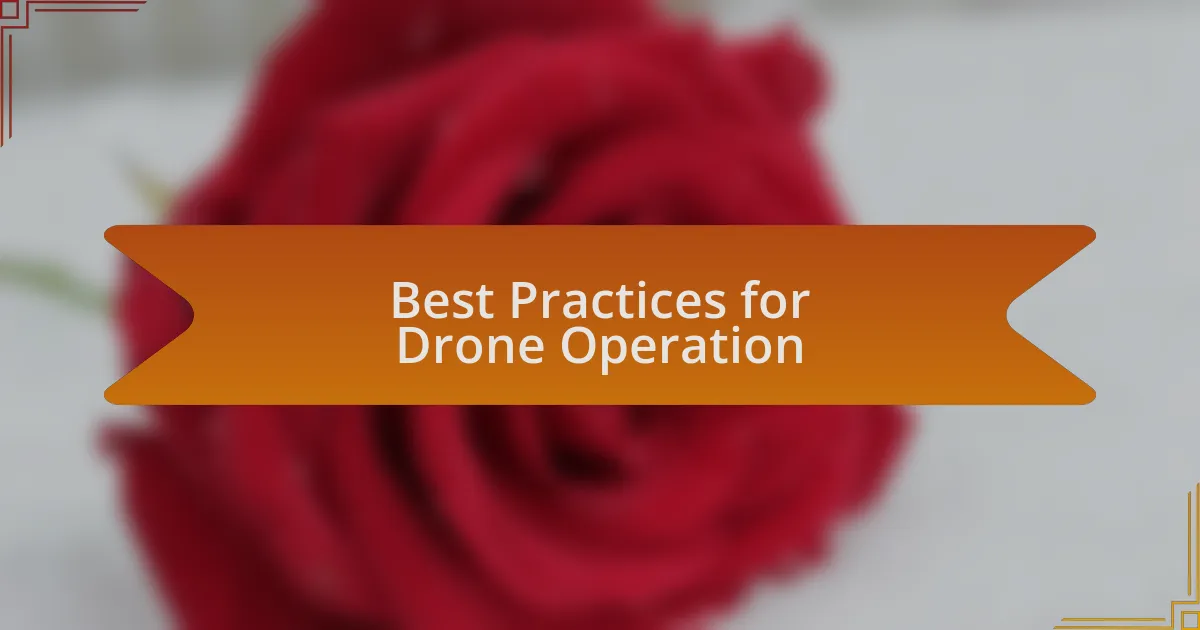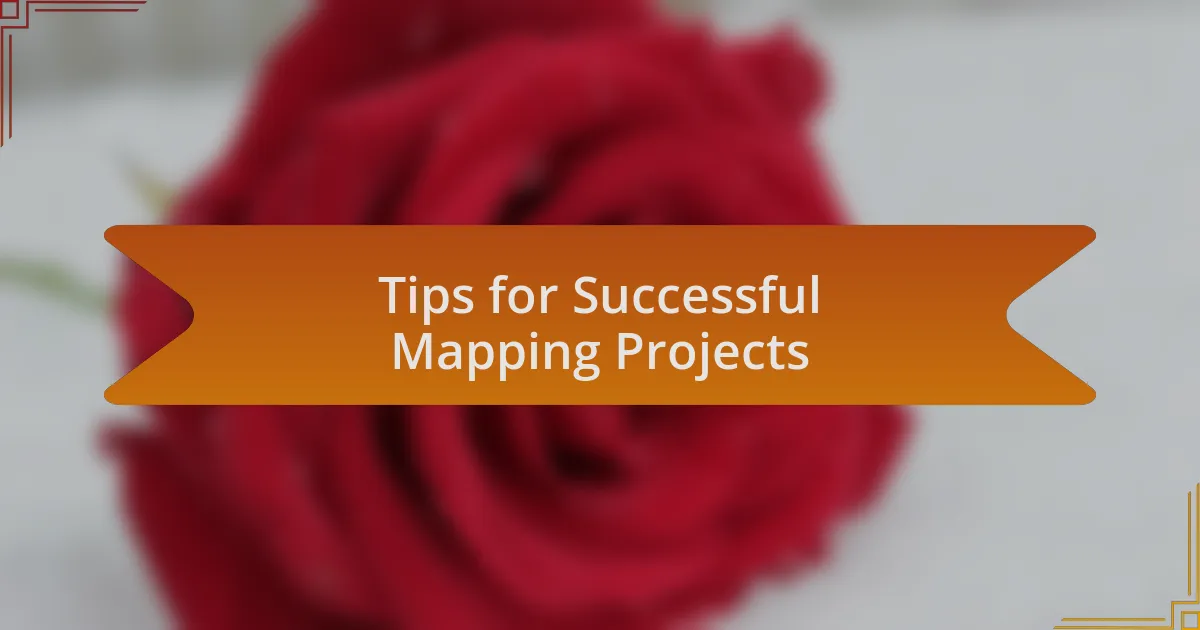Key takeaways:
- Mapping Zanzibar markets enhances navigation for locals and tourists, supporting small businesses and preserving cultural narratives.
- Utilizing high-quality drone equipment and GIS software is essential for creating accurate and detailed maps.
- Pre-flight planning, steady altitude maintenance, and community engagement are critical for successful drone operation.
- Successful mapping projects require preparation for diverse conditions, patience in detail capture, and collaboration with local experts for enriched insights.

Importance of Mapping Zanzibar Markets
Mapping Zanzibar markets is crucial for understanding the intricate web of trade that defines the local economy. I remember my first visit to Darajani Market; the vibrant chaos was overwhelming yet fascinating. A well-structured map can help newcomers navigate these bustling spaces, enhancing their shopping experience while shedding light on local vendors and their products.
From my experience, knowing the layout of these markets can elevate your exploration significantly. Have you ever wondered how you could find that perfect spice vendor hidden among countless stalls? Mapping enables not just tourists but also locals to support small businesses, fostering a sustainable economy that thrives on community relationships.
Moreover, precise mapping of Zanzibar’s markets can aid in preserving cultural heritage. Each stall tells a story, and when we capture that through maps, we ensure these narratives are not lost. I feel there’s something magical about tracing the paths that generations have walked, connecting us to the past while promoting future growth.

Essential Drone Equipment for Mapping
When it comes to drone mapping, the choice of equipment can make all the difference. In my experience, a high-quality drone with a decent camera, like the DJI Phantom 4 RTK, provides the precision needed for mapping intricate spaces like the bustling streets of Stone Town. I still remember the first time I used this drone; the clarity of the images completely transformed the quality of my maps, revealing details I had previously overlooked.
In addition to the drone itself, proper software is essential for processing the collected data. I suggest using GIS (Geographic Information Systems) software such as Pix4D or DroneDeploy. These tools allow for an efficient workflow, and I found that they help in stitching together images seamlessly, creating a comprehensive map that showcases the market’s layout beautifully. Have you ever tried turning raw data into something visual? It’s incredibly rewarding!
Lastly, don’t underestimate the power of additional accessories, such as extra batteries and a reliable ground control station. I remember running out of battery right before capturing the final images of the market, which taught me the importance of preparation. It’s these little details that can either enhance your aerial mapping experience or leave you scrambling at the last minute.

Best Practices for Drone Operation
When operating a drone for mapping, pre-flight planning is critical. I always create a detailed flight plan, which includes setting waypoints and defining the area I intend to cover. I remember a time I skipped this step and ended up missing key areas of the market. Have you ever had that sinking feeling of realizing you’ve overlooked something important?
Maintaining a steady flight altitude is another best practice I’ve found invaluable. Staying consistent at the right height ensures that the images collected are uniform, providing high-quality data for analysis. I once captured images that were slightly off due to varying altitudes, and the extra work to correct this during processing taught me that a little attention upfront can save hours later.
Lastly, always respect local regulations and be aware of your surroundings. Engaging with the local community often enhances the flying experience; I’ve had a few wonderful conversations with market vendors, who even shared insights about the area that improved my mapping approach. How much richer can your data be when you connect with the people around you?

Personal Experiences with Zanzibar Markets
As I wandered through the vibrant stalls of the Zanzibar market, the rich tapestry of colors and textures captivated my senses. I remember stopping at a spice vendor, who offered me samples of cardamom and cloves. That moment was not just about the spices; it was an immersion into the local culture. How many times have you tasted something that transported you to a different place?
One day, I stumbled upon a handmade crafts stall run by a warm-hearted artisan. Our conversation flowed easily, and he shared the stories behind his creations. It made me realize that these markets aren’t just about transactions; they’re about connections. When was the last time you connected with a stranger over a shared passion?
I also found that the best times to visit the markets were early in the morning. The energy was electric, with vendors setting up and the aroma of fresh produce filling the air. That bustling environment fueled my excitement for drone mapping, as I embraced the lively spirit of Zanzibar. Doesn’t a little chaos sometimes add to the thrill of exploration?

Tips for Successful Mapping Projects
When embarking on mapping projects in Zanzibar, preparation is key. I recall my first attempt where I underestimated the diverse terrains and sudden weather changes. Before heading out, I now always review weather forecasts and prepare my drone for various conditions—it’s a game changer. Have you ever been caught off guard by the elements?
As I worked on my last mapping session, I learned the value of patience. During my initial flights, I rushed through the process, only to realize later that taking the time to capture the details led to far better results. This taught me that sometimes, slowing down and focusing on the finer points can yield more meaningful data. Have you considered how taking your time can influence your outcomes?
Collaboration also transformed my mapping experience. Partnering with local experts provided insights that I couldn’t have accessed on my own. One instance stands out when I worked alongside a local guide who showed me uncharted areas rich in cultural significance. This connection not only improved my project but deepened my appreciation for the community. Are you leveraging local knowledge to enrich your mapping projects?